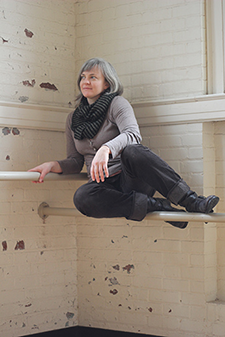
Teaching Philosophy
In teaching modern dance, ballet, and improvisational techniques, I draw from my traditional and non traditional training. They all work together in providing the dancer with the important skills and experiences necessary to his or her development as a student and artist. I believe in finding the freedom of movement within the fundamentals of one's technique. Students need a variety of tools to transform themselves into dance artists, just as a carpenter needs many tools to build a table. My background, training and experiences are my building blocks, my foundation.
My training started with a mixture of classical (Chicetti and Russian) ballet, continued with traditional (Graham, Limon, Cunningham,Wigman/Holms and Horton) techniques to the more post modern techniques (Release- Brown, Klein/Mahler, Laban/Bartenieff,), then progressed to exploring improvisational, site-specific and collaborative work. When I teach I keep the progression of these techniques in mind. When teaching a beginning level class I focus on the basic elements of alignment, core strengthening, upper body strength and finding the breath, progressing later to the center of gravity, weight shifting and sharing, off-balance movement and the articulation of the upper body. In more advanced classes all of these elements are combined in a single phrase in addition to directional changes, quick spirals into and out of the floor, variation of tempo, inversions, and use of space. I strongly support and encourage my students to embody new movement and make it their own. As an educator a goal of mine is to cultivate well adaptive dancers who are able to make quick, in the moment, decisions or adjustments within the framework in which my students are given. The development in memorization of movement and phrasing, demonstration, directional shifts, discussion, improvisation and group/individual exploration is emphasized and encouraged. The exploration of personal connectivity and growth is encouraged throughout class.
Another goal of mine is to create artists, not just well trained dancers. Dancers must have individual personalities, which are expressed through their movements. I want to encourage students to find their original voices throughout the progression of the class. I want to cultivate an environment of investigation and discovery by encouraging students to ask questions about the movement and how they can embody it and make it their own. I do not want students to think of themselves as cogs in an assembly line, but rather like brushstrokes in a painting. Each student is just as important as the next, different but equally essential individually and to the overall picture. I want to cultivate and create artists who find their own ideologies. I would like to give my students the essential tools with which they will be able to generate ideas and forge solutions to creative and performative obstacles that arise.
I also want to acknowledge the importance of our predecessors. Keeping in mind that what has been done before us is just as important to what we as movement artists do today. Learning from our past helps us in developing the future, and in moving forward and creating new avenues, we better our craft. A wise philosopher once said, “If we see so far it is only because we stand on the shoulders of giants.” We gain crucial information from the findings of those before us, without that knowledge dance would not be where it is today or tomorrow.
I would like for students to feel like they are important entities within a community